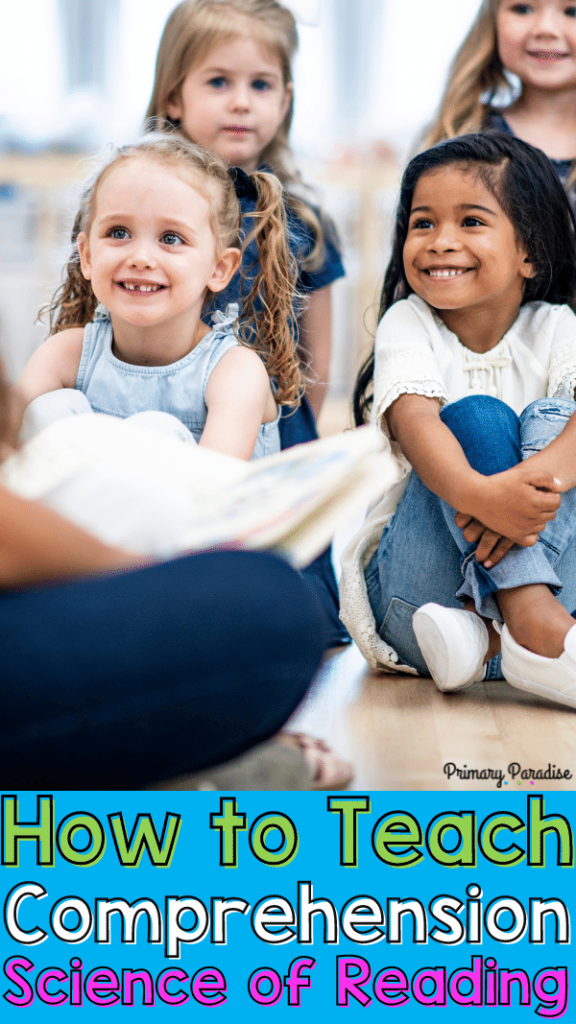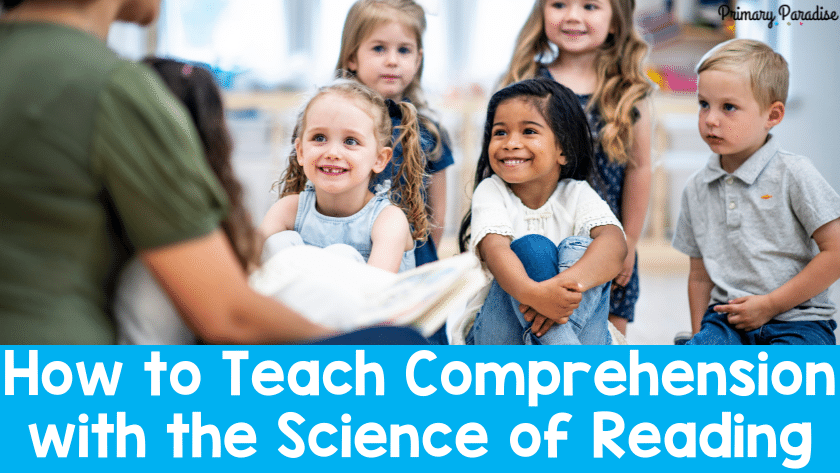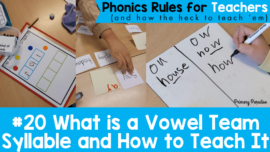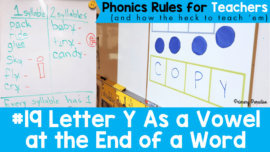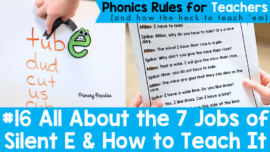The Science of Reading might feel like a hot, new buzz word. All of this talk of heart words and word mapping might be a bit different from a balanced literacy approach you are used to. When you get down to it, the Science of Reading is not new at all. It’s simple researched based instructional practices. But, what about reading comprehension? You might ask. Where does that fit in when you’re mapping words and looking for heart parts? In actuality, comprehension and vocabulary skills are very much entwined in the Science of Reading. Here is how to teach comprehension in a Science of Reading based classroom.
Why isn’t comprehension a big part of the Science of Reading?
If you’re new to this literacy approach, you might wonder why comprehension isn’t important. If you are going by what you see on Instagram, it might look like comprehension is being left behind. The truth is, it is a huge part of a science based approach to reading! In fact, comprehension is, of course, the goal of reading. The problem is that it is not the part of reading instruction that is getting attention right now.
This is because how to teach sight words and other words through word mapping is different from the balanced literacy approach. Understanding that decodable readers that follow a set scope and sequence are a better tool than leveled readers is different as well. So, these things, understanding letter sounds, understanding how to truly teach sight words in a brain friendly way, understanding the downfalls of the three cueing system, and the importance of understanding how the English language words have come to the forefront.
However, that doesn’t mean that reading comprehension is not part of the science based research on reading. It is, of course very much. In fact, many of the things teachers do in connection to reading comprehension don’t need to change. They just might need to tweak a few practices to do it in a more brain-friendly way.
How to Teach Reading Comprehension Using the Science of Reading
Reading comprehension is a vital part of reading because it’s the end goal. So, of course as teachers we still need to work on reading comprehension skills such as understanding plot, problem, solution, characters, predicting, inferring, and more. Here are the ways we can effectively teach our students reading comprehension skills. You are likely to find much of this is what you already do, and other things might only require a few tweaks.
The one big shift you’ll need to make
The big change you might need to make is shifting the focus from your guided reading table. Instead of focusing on student comprehension when they’re reading to you, the focus should be on decoding. Why? Because asking beginning readers to decode and then comprehend while they are learning new sounds is a tall order.
When students are reading decodable books in kindergarten, first, and into second grade, they should be reading to practice new sounds they’re learning and review older sounds. Of course, when they’re reading independently, they can read books that take less work (and they should read books that bring them joy during this time). However, when students are actively working with you to learn and solidify new sounds, their brains are working hard. It often isn’t going to be a valuable conversation about the story because their focus is on decoding new sounds and words.
While comprehension is the goal with reading, this is not the best time to focus on it. Of course, there’s nothing wrong with asking students some comprehension questions while you’re working on new sounds, but they will only really be able to be surface level questions. Why? Because the text is likely not very rich and complex. The goal here is decoding. So, it doesn’t mean you can’t ask comprehension questions. It just means that it’s not going to help students develop deep and rich comprehension skills. Once students have a firm understanding of letter sounds and can easily decode, then you can begin to focus on comprehension during guided reading. Normally this is sometime in the second grade, but could be earlier or later depending on the student.
So, how do we help their reading comprehension skills go deep and wide while they’re still learning to break the reading code? Here are 6 ways we can do this in a science based way.
5 Ways to Teach Reading Comprehension to Emergent Readers
Use read aloud time to focus on reading comprehension
If we want our students to be able to comprehend rich, complex texts on their own, the best way might seem a bit strange. After all, the goal of reading is for students to be able to decode words, understand what they’re reading, make connections, and then go further. This a a complex task, so the best way to do this is to remove one potential barrier to start.
According to science, comprehension skills need to be the focus when students aren’t also focusing on decoding. If you’re already reading aloud to your class often, you probably already do this. Use whole class read alouds to focus on comprehension skills. This removes the barrier of trying to decode and comprehend at the same time. As you probably already do, you can introduce things like plot, problem, solution, characters, prediction, inferring, and setting by creating anchor charts together. Then, choose rich mentor texts to read to your class. Pause frequently to discuss whatever skills or topic you’re focusing on.
Remove the barrier of decoding to develop meaningful comprehension skills
By taking away the expectation to both decode and comprehend at the same time, you’re making it easier for students to dig deeper into the text. It also always younger students to comprehend more difficult texts and ideas. This then improves their background knowledge and vocabulary which is a huge component and predictor of strong comprehension skills.
This is another great use for audio books in your classroom as well as utilizing listening centers. Students can listen to audiobooks and then focus on retelling the story or other comprehension skills. When we remove the added layer of decoding, it will help even reluctant readers comprehend literature in a deep way and feel more confident in their abilities.
If you’re teaching a child to play baseball, you’ll likely start by teaching each skill in isolation. First you they practice hitting the ball, then catching, then throwing, and finally running the bases. The end goal is to be able to play the whole game, but if you try to throw them into a game right away, they’re likely to be overwhelmed and not even want to try. It’s the same with reading. Isolating the skills of decoding and comprehension separately gives students the confidence to then put the two skills together.
Focus on oral language
Oral language, or spoken language, is a key component of comprehension skills. After all, our end goal of decoding and comprehending at the same time requires children to decode the words on the page, turn them into spoken language (either out loud or in their head). They then need to comprehend, or understand, and interpret that spoken language to make meaning. By focusing on oral language skills, you can help improve your students’ reading comprehension skills! Here are three ways to focus on oral language in your classroom.
Focus on meaningful conversations
The first way to focus on oral language is to engage in frequent classroom discussions with your class. These discussions could be during morning meaning or circle time, number talks, or while discussing science or social students lessons. You could even have a question of the day. Ask students to discuss serious things like how to stop global warming or silly things like whether green is the best color.
Truly, the topic isn’t important. What is important is that students practice the skills of speaking to be understood and listening to understand. You can help students develop these skills by setting shared expectations for discussions, helping to restate or clarify what students are saying, or asking follow up questions. The goal, eventually, is to have less and less teacher support.
Focus on vocabulary
A huge part of reading comprehension is having the vocabulary to understand a wide range of words. So, taking time each day to focus on new vocabulary is setting your students up for reading comprehension success. The key is giving students the change to encounter, grapple with, and then think through the meaning of new and different words. Even students will a good vocabulary benefit from deepening their knowledge of a word. Here are a few ways to bring vocabulary to the forefront in your classroom.
Look for teaching opportunities.
When a new or complex word comes up in a story you’re reading or in a conversation, take the time to explore the word. This could mean asking any students if they know what a word means. You could look it up in a dictionary or online. You could also practice acting it out together. Any time a student points out a word they don’t understand, that a chance to deepen and expand vocabulary.
Use big words.
Often adults are afraid to use big words with children, but I encourage you to do the opposite. Sprinkling more rich and complex vocabulary in your normal every day speech helps to expose students new words. It’s important to speak in a way students can understand you. But describing something “large” as “massive” or something “hot” as “scorching” is a great way to expand students’ vocabulary. Make sure students are comfortable to ask what things mean, but sprinkle those big words around in your speech.
Define as you speak.
In addition to using big words, you can define words as you speak. This works well if you are fairly certain you’re using a word some students don’t know. Here’s an example. “I saw a student sprint, or run really fast, through the hall”. You can simple include the definition within the sentence. Of course, not every child will pick up on the new word, but this is just a simple way to expose students to a wider range of vocabulary.
Let students explain word meanings.
When a student asks what a word means, first open it up to the class to see if someone else knows the meaning. Often, kids are better at explaining things in kid language. If they define it correctly, there’s no need to explain it again. Instead, you could ask for or give examples or have the students act it out. If they explain it incorrectly, you can open it up to discussion, or if you’re short on time, tell them nice try and define it yourself.
Choose spelling words with vocabulary in mind.
If you’re required to give spelling words, you can choose some words with vocabulary in mind. The nice thing is that it doesn’t mean you need to pick long words, but you can look for words that follow the spelling pattern you are focusing on that are less common. I wouldn’t recommend making every word hard and uncommon, but picking one or two is an opportunity to expand vocabulary.
Of course, this means you need to take the time to define the words. We personally start each week with an introduction to our sound. Then we create a tiny book where students write the word and then draw a picture to help them recall the meaning of the word. For example, if you are focusing on the /aw/ spelling pattern, your words might be saw, paw, law, crawl, draw, yawn, straw, and flaw. Choosing the word flaw gives you an opportunity to discuss the meaning of a likely new word.
Have a word of the day or week.
The last way to focus on vocabulary is much more direct. Focus on a word of the day or word(s) of the week. Spend 5 minutes a day explicitly discussing, defining, and using the word. If you’re in an IB school like I am, you can use the vocabulary that goes along with your Unit of Inquiry to select words. If not, you can do some research and find some vocabulary words to choose from online. Here is a great example of lists by grade. You could even ask students to choose the words you focus on by making it a class job.
To practice the word, define it and discuss the meaning. Give examples (or have students give examples) of how to use the word. Then, if possible, act it out. Lastly, encourage your students to use it in context that week or day. You can also use it in context as well. You could create a tally chart on a corner of your white board to tally every time you hear the word used correctly in context for an added bonus.
Focus on problem solving skills
Another way to focus on oral language skills that will aid comprehension is focusing on problem solving and conflict resolution skills. Students have to be able to listen to understand and speak to be understood when resolving conflict. You can read this post to learn how to focus on problem solving and conflict resolution skills. Besides being necessary and practical, conflict resolution skills will develop oral language skills which will in turn build comprehension skills.
Focus on background knowledge
Oral language and vocabulary are just one part of improving students’ comprehension skills. Another big part of strong reading comprehension is developing background knowledge. For example, if students are reading about a festival in Peru and can understand all of the vocabulary but have no idea where Peru is or anything about the country, they will likely struggle to fully grasp the text. If students are reading a passage about snow, but live somewhere that it never snows, a lot of the nuance will be lost on them. This is why solid science and social studies instruction is so important. It can be easy to think that reading, writing, and math need to take center stage. However, learning about the world around us builds necessary background knowledge for good comprehension skills.
Move towards combining comprehension and decoding
As I stated already, the goal of reading is comprehension. So, this means that, as our students master more and more spelling patterns, you can move towards combining decoding and comprehension. Once students are reading more complex books, you can and should begin to focus on comprehension explicitly when they are reading the text themselves. It greatly depends on the child. Anywhere from the end of first grade to the end of second grade, they will have a good amount of spelling patterns and decoding becomes much more fluent.
Please don’t misunderstand. As students are reading simple decodable readers that grow more and more complex, they are likely also comprehending more and more of what they’re reading. This naturally occurs as they become more skilled readers. It’s just that, this shouldn’t be our mode of instruction for comprehension at first. Of course, children can read “the cat sat on a mat” and identify the character (cat) and what happened (cat sat). They can probably even predict what will happen next (he will take a nap for example). But, this level of comprehension isn’t very deep and it doesn’t allow much discussion or thought process.
By waiting until our students are able to decode more complex texts and, in the meantime, focusing on comprehension through read alouds, audiobooks, discussion, vocabulary and background knowledge building, we set them up for success. Once they are to the point where they are decoding more complex texts, we can dive right into deep, meaningful discussions and analyses of the book. It won’t be new to have deep meaningful discussions of texts. As students are more comfortable decoding, we can slowly combine the two skills of decoding and comprehension in a more concrete way.
Make comprehension the goal at home
My last suggestion needs some explanation. Although I am not a fan of homework at all, I recognize that it is often a requirement. If you are required to send home homework, instead of of making the focus students reading and decoding, I would shift the focus. It is often hard for parents to truly know how to support their early readers.
Instead, you can have the focus be on parents reading to their child and then focusing on discussing the book together. You can send home this free parent support guide for reading . It includes questions to ask before, during, and after reading. Of course, you can send home decodable texts for students to practice with parents. However, it’s important to ensure that they are texts with sounds the children will be able to read. Personally, I would rather a student cuddle up with a parent, listen to a story, and talk about it. They can leave the decoding practice to me.
The focus of the Science of Reading posts on social media might not be comprehension. But it is a huge part of the research on reading. Reading comprehension is still the end goal for reading. We just need to shift our focus and be willing to teach both skills in isolation so they can come together in the end.
